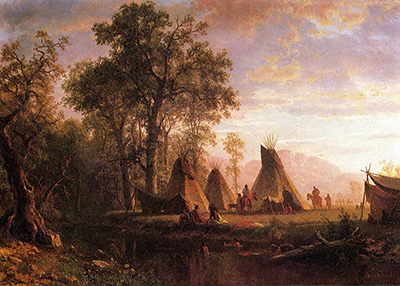Albert Bierstadt was a German painter and a master of his craft. He is best known for his great work of art on landscapes mainly found in Western America. One of his greatest paintings of all time is the Indian Encampment Late Afternoon.
The painting was crafted in 1862 and was inspired by Indians who resided in the West. During his first visit to this region, Albert was astonished by the Plains tribes and their way of life. Their lifestyle and land terrain spoke to his artistic instincts, and he thus came up with this masterpiece. However, this painting was completed later on in his life at his studio in New York. Critics, however, have it that Albert did not experience this scene first hand, but it was only a figment of his imagination. The structure of the image was informed by the existing cultural attitudes of the nineteenth century.
The image is about Plains Indians who are seemingly basking in the afternoon sunset outside their camps. However, there is a deeper meaning to this painting. The sunset is used as a symbol to represent the vanishing race of American Indians. However, later on, this was found to be only a misconception as the race is still in existence. To further describe the image, some trees are visible, and a couple of local folks are on horseback. In addition, the sunset displayed on the image gives the impression that the setting is in a late afternoon, and one can see some mountains from a distance.
Theme
The theme of this painting is rather calm and relaxing. The sunset is very well crafted and oozes a calm feeling when one pays a keen eye to it. Further, the folks are going about their business as usual.
Location
As stated earlier, this painting was completed by Albert Bierstadt in his New York studio but was started in 1859 during his tour to the West. It was completed in 1862 and has been on display since then. Its dimensions are 50.8*71.1 cm originally. However, the medium on which it was painted in oil on canvas was a rather popular method of painting during the mid-nineteenth century. If you are an art enthusiast or a fan of Albert’s work, you can get to view the painting in Crystal Bridges Museum of American Art. It is located in Bentonville, Arkansas. Bring your friends and family to experience the works of Albert firsthand.




